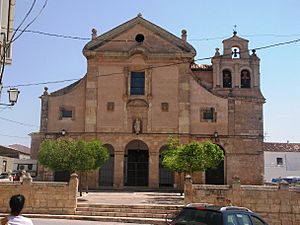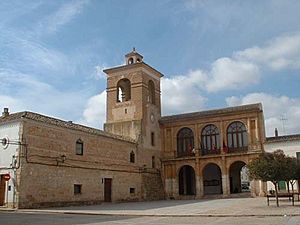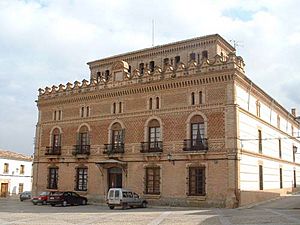Villanueva de la Jara facts for kids
Quick facts for kids
Villanueva de la Jara
|
|||
|---|---|---|---|
|
municipality
|
|||
 |
|||
|
|||
| Nickname(s):
Spanish: Jareño, jareña
|
|||
| Country | |||
| Autonomous community | |||
| Province | Cuenca | ||
| Comarca | La Manchuela | ||
| Comarca | Manchuela Conquense | ||
| Municipality | Villanueva de la Jara | ||
| Founded | Roman remains. Grant of villa since 1476 |
||
| Area | |||
| • Total | 156 km2 (60 sq mi) | ||
| Population
(2018)
|
|||
| • Total | 2,304 | ||
| • Density | 14.77/km2 (38.25/sq mi) | ||
| Time zone | UTC+1 (CET) | ||
| • Summer (DST) | UTC+2 (CEST) | ||
Villanueva de la Jara, often called La Jara, is a small town in the Manchuela Conquense area of Spain. It is located in the province of Cuenca, within the region of Castile-La Mancha. This town is famous for growing mushrooms, especially portobellos. Growing and selling these mushrooms is the main way people in Villanueva de la Jara make a living.
Contents
History of Villanueva de la Jara
Villanueva de la Jara was started by people from a nearby town called Alarcón. This happened a long time ago, either in the 1200s or 1300s. The town became independent in 1476. This was thanks to the Catholic Monarchs, who were the rulers of Spain at that time.
The town played an active part in the Castilian War of the Communities. This was a big conflict in Spain. Later, during the War of the Spanish Succession, parts of the town were damaged. An emperor named Charles VI, Holy Roman Emperor caused some destruction. During the Spanish Civil War, Villanueva de la Jara had an airfield. This airfield was used by groups called the International Brigades.
Following Saint Teresa's Path
Villanueva de la Jara is part of a special route called the Tracks of Saint Teresa of Ávila. This route is for people who want to go on a pilgrimage, or just enjoy tourism, culture, and history. It connects 17 cities where Saint Teresa of Ávila started new religious communities. There is no set order or time limit for this journey. Each visitor can explore it at their own pace.
How Far is Villanueva de la Jara From Other Cities?
Here are the distances from Villanueva de la Jara to some other cities in Spain:
Main Places to See
Villanueva de la Jara has many interesting old buildings and monuments.
Rollo de Justicia
The Rollo de Justicia was built in the 1400s. It was a symbol of the town's right to have its own laws and justice. In the past, people who broke the old laws were punished here. It is a tall, round stone pillar, about 3.5 meters high. It has four openings, one on each side.
Plaza Mayor (Main Square)
The Plaza Mayor is the heart of Villanueva de la Jara. Many important buildings are located here:
- The Town Hall is a beautiful building from the 1500s. It is built in the Renaissance style. Some people think an Italian architect named Andrea Roddi designed it.
- The old Granary was built between the 1400s and 1500s. It is next to the Town Hall and is now a Medical Center.
- The Torre del Reloj (Clock Tower) is a reminder of the town's first Town Hall building from the Middle Ages. It has three floors.
- The Posada Massó is an old inn from the 1500s. It is a great example of a traditional Castilian inn. Travelers and workers used to stay here. The building has a wooden roof and brick arches.
- In front of the Town Hall is Villa Enriqueta. This grand house was built in 1899. It has a special style called Neo-Mudéjar, which uses brick patterns. It was first a private home, then a military hospital during the Spanish Civil War. Today, several families live there.
- A Guardia Civil Barracks House from the 1900s is also in the square.
Basílica de Nuestra Señora de la Asunción
This large church was built in the 1400s. It was made using stones from an old Moorish castle that used to stand here. The church you see today was rebuilt in the 1500s. Its bell tower has a pointed top. The main entrance is a grand Neoclassical style portal from the 1600s or 1700s.
Inside, the church has a wide main area from the 1500s with special arched ceilings. The main altar has a beautiful Baroque altarpiece from the 1600s. It features a copy of a statue of the Assumption of the Virgin Mary. The original statue was lost during a war. The church also has a lovely Rococo chapel from the 1700s. This chapel is highly decorated with murals. You can also see a pulpit from the 1600s and a sculpture of Christ from the 1500s. There is a museum inside the church called Museo de la Sacristía.
Iglesia del Carmen
This church was built in 1587 by Carmelite friars. They came to Villanueva de la Jara after Saint Teresa of Ávila visited. The church has a simple design with one main area and a dome. The main altar has a simple altarpiece. In the center is a statue of the Virgin de las Nieves, who is the patron saint of the town's Catholics. This statue is from the 1300s. The church also has a pulpit from the 1700s.
Convento de las Carmelitas
This convent was founded by Saint Teresa of Ávila herself in 1580. It includes a church, the convent building, and a cloister (an open courtyard). It is a large building surrounded by walls. Inside, you can see paintings from the 1600s and a special wooden ceiling called a Mudéjar roof. It also holds the tomb of its first leader, Sor Ana de San Agustín.
Other Interesting Places
- Casa de la Música: A house dedicated to music.
- Convento de Concepcionistas: A convent from the 1500s in the Renaissance style.
- Ermita de San Antonio Abad: A small chapel from the 1700s.
- Laundries of the Valdemembra river: Old washing places by the river.
- Colegio de la Latinidad: A college built in the 1800s with a mix of styles.
- Manor houses: Several grand old homes.
Other Towns in the Municipality
The municipality of Villanueva de la Jara also includes these smaller towns:
- Casas de Santa Cruz
- Ribera de San Benito
See also
 In Spanish: Villanueva de la Jara para niños
In Spanish: Villanueva de la Jara para niños







